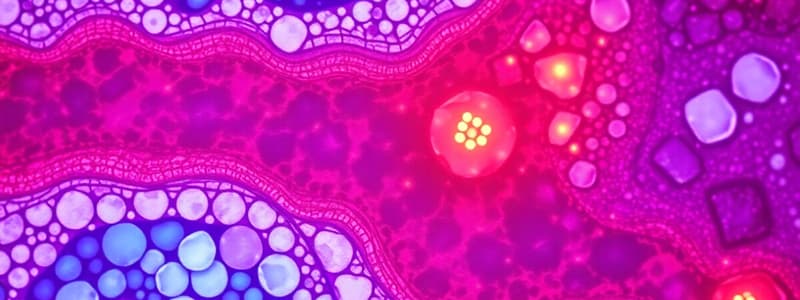Podcast
Questions and Answers
What are the four main types of tissues?
What are the four main types of tissues?
Epithelial, Nervous, Connective, Muscle
Histology is the study of bones.
Histology is the study of bones.
False (B)
Which of the following structures is characteristic of epithelial tissue?
Which of the following structures is characteristic of epithelial tissue?
- Loosely arranged cells
- Absence of junctions
- Presence of goblet cells (correct)
- Tightly packed cells (correct)
What is the function of the apical surface in epithelial tissue?
What is the function of the apical surface in epithelial tissue?
Endocrine glands secrete into the ______.
Endocrine glands secrete into the ______.
What is keratinized tissue?
What is keratinized tissue?
Match the following types of epithelial surfaces with their characteristics:
Match the following types of epithelial surfaces with their characteristics:
Flashcards are hidden until you start studying
Study Notes
Tissues Overview
- Tissues consist of similar cells that collaborate to perform specific functions.
- Four main types of tissues: Epithelial, Nervous, Connective, and Muscle.
Epithelial Tissue Characteristics
- Histology is the branch of biology that studies the microscopic structure of tissues.
- Epithelial cells are tightly packed and connected through tight junctions, gap junctions, and desmosomes.
- Functions include protection, covering exposed surfaces (e.g., skin), and lining internal passageways.
- Epithelial tissue also has secretory functions, forming glands.
Types of Glands
- Endocrine glands: Release hormones directly into the bloodstream.
- Glands possess a free surface, known as the apical surface, which faces the external environment or internal cavities.
Surface Structures
- Apical Surface: Positioned at the top layer of epithelial tissue, interacting with air or other surfaces.
- Goblet Cells: Specialized, unicellular glands found within epithelial tissue that secrete mucus for lubrication.
- Keratinized Epithelia: Feature dead cells filled with keratin protein that provide added protection against abrasion and damage, commonly found in the skin.
Basal Surface and Basement Membrane
- Basal Surface: Anchored to the underlying basement membrane, ensuring tissue integrity.
- Basement Membrane: Composed of collagen and glycoproteins, it supports the overlying epithelial cells and acts as a filter between the epithelium and connective tissue.
Studying That Suits You
Use AI to generate personalized quizzes and flashcards to suit your learning preferences.





